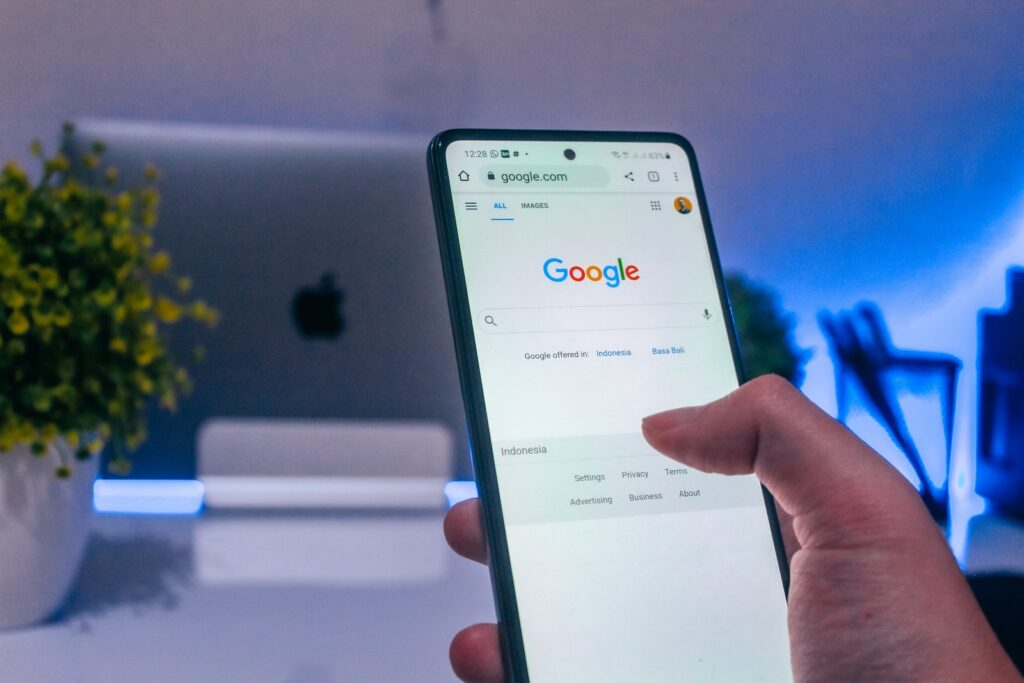Why mobile friendly websites are good for Google AND for your clients

There’s no way back: Google first boosted the ranking of mobile-friendly pages on mobile versions of search results worldwide in 2015. Now in 2021, mobile is officially king. Nowadays, the Google algorithm has been honed to prioritise mobile- over tablet- and desktop-friendly sites in all search results. So websites that are optimised for mobile will come up before other results in search, regardless of the device they are being served up on.
Why mobile-friendly web design is important
According to Statista, mobile devices (excluding tablets) generated 54.8 percent of global website traffic in the first quarter of 2021. That’s a lot of people searching for local information on their mobile phone. And funnily enough, a huge percentage of mobile searches happen at home or at work (when we’re not in lockdown…), places where desktop computers are likely to be around. With the latest version of the Google algorithm, non mobile-friendly pages won’t easily appear in searches, giving priority to mobile-friendly, high-quality and relevant results. This affects search in all languages globally and applies both to individual pages and entire websites.
Mobile isn’t a trend, nor even the future; it’s the present. So get your potential clients to what they came for as soon as you can by rethinking the way you communicate with your audience. As a business owner, it’s natural for most of your interactions with your own website to be on your desktop computer, because that’s where you are when you’re working on it. Thinking mobile-first is also about thinking about the way your potential clients interact with your website, and their patterns of use will be very different from yours. For a lot of leads, the first chance in the day they may have to get around to looking for a service they need might be when they’re in front of the tv at the end of the day, mobile in hand. We’re all increasingly becoming accustomed to getting what we want when we want it; which is exactly how people search for products and services like yours.
Mobile-first design
You may have heard the term ‘digital first’, which has been around for many years now as businesses everywhere turn their focus towards a digital-first business strategy. In much the same way, mobile first is nothing new, but it is definitely a new mindset for traditional professional services firms, for whom offline services and offline marketing is a familiar and therefore easy-to-navigate landscape. But that landscape is producing diminishing returns, even for professional services. So changing mindset to think not only of a digital-first business strategy, but also of a mobile-first marketing approach is a new way of conceptualising the ways in which clients find and interact with your business online.
What is a mobile-friendly website?
A mobile-friendly site is basically a site that is legible and immediately usable on a mobile device. A mobile responsive design will include content that scrolls within the device screen and responsive images that scale based on screen size. Mobile visitors can easily read it and quickly find the information they need with simple navigation options.
A non-mobile-friendly version requires the mobile user to tap or zoom to read the content. Tap targets are not spaced appropriately (still a common problem in 2021) and there is unplayable content or horizontal scrolling. These unpleasant navigation experiences frustrate mobile users and ultimately make them abandon the site without the information they were looking for. This is not a good outcome for your business, or your website in the eyes of Google.
Mobile friendly websites with responsive design
Google recognises three different configurations for building mobile sites that you may have heard of in your exploration around what mobile requirements you need for your website. The main thing you need to know is that Google prefers responsive web design — and so do we. The three configurations you may have heard of are: responsive web design (design that scales across all devices), dynamic serving (different code served up dependent on the device detected) and separate URLs designed for different device specifications (so a lawfirm.com desktop site for desktop customers and a separate m.lawfirm.com mobile site for mobile customers). Another problem with creating multiple versions is that with the proliferation of smartphones, there is no longer a single standard mobile screen size to use as a guide for different screen sizes, requiring a myriad of versions or code alterations to create mobile sites that suit every mobile device. Sounds expensive, right? It is — that’s a whole lot of extra work to create additional web designs for multiple screen sizes.
Benefits of mobile friendly websites for businesses
One of the main benefits of responsive web design is that you’ll only need to maintain one version of your website for multiple devices. This is obviously significantly cheaper for your web design costs compared with designing a separate mobile version, tablet version and desktop version. A single responsive website is also easier for businesses to manage because you don’t need to keep multiple versions of the site up-to-date (admin nightmare!). With responsive design favoured by Google, it’s an easy go-to; so unless your site has some major custom requirements, this is an easy decision.
Benefits of mobile friendly websites for your clients
Your clients get a consistent user experience across their devices for a seamless experience of your brand in a familiar and intuitive way regardless of the device they are using. A consistent user experience also means they’ll spend less time learning how to use your site and more time getting what they want from it. This is good for you and good for your site in the eyes of Google and your search rank. The more useful your site is to leads, the more sales you will make. The longer leads stay on your site—which is helpfully answering all of their questions—the more Google credits is as a good answer to a search query.
Website optimisation to avoid mobile site errors
Aren’t all websites mobile-friendly in 2021?
Since first publishing this article in 2015, I’ve seen a shift from most sites having very little mobile optimisation, to most sites these days having made an attempt to be readable on a mobile device. Usually this is because sites have been designed using a responsive site framework, however many designers don’t take any additional steps to further optimise websites for mobile users. However, many sites I come across will still have a bunch of mobile experience errors that haven’t been given the consideration they need.
Responsive design is often limited to one-size-fits-most
Mobile responsive design can still be vulnerable to mobile site errors, but these errors usually stem from a responsive design that has not been also optimised for mobile phones. This is a common issue with drag and drop page builders like Wix and Squarespace, or when using inexperienced web designers who aren’t well-versed in Google Search Console and mobile optimisation strategies. For sites that are not optimised beyond their out-of-the-box, one-size-fits-most settings, but there will always be elements that aren’t mobile friendly because the entire design is finding the most common denominator between desktop, tablet and mobile versions, that just can’t possibly work perfectly for all three.
Mobile-specific elements optimise a responsive framework
While I still design the occasional website in Squarespace, having greater control over these elements is one of the main reasons why I love my current WordPress setup. For the WordPress websites I design, I have exceptional control over elements, giving me flexibility to create custom mobile-friendly sections and individual elements that I can turn on and off using code depending on the device. So with more flexible tools used to build your website, unfriendly mobile elements can be removed and refined for the best results on mobile screens without the need for a separate mobile site.
If your web designer is careful to follow Google guidelines, your website can be designed to ensure fast mobile load speed, adequate spacing of elements for finger taps instead of mouse use and additional custom mobile-specific elements to ensure the best possible user experience for your mobile users and potential clients—all common mobile errors with responsive design that can be fixed with know-how and planning.
Is your business website mobile friendly?
You can test the pages on your website to determine their mobile-friendliness over on Google’s Mobile Friendly Test.
Responsive design is the preferred configuration for serving up mobile content because it keeps the cost of website design lower, while also reducing the longterm admin burden on your business. A responsive website helps to engage clients for longer and can help you get more new clients with a well-positioned site that maximises search engine rankings.
Mobile-friendliness is just one factor of many that contribute to the success of your website and a professional reflection of your business online. Check out our Buyer’s Guide to Web Design for a look at the important strategic elements that your should be looking for in choosing a web designer for your business.
Your designer should know their onions if they’re going to create a responsive design properly configured for a mobile device; make sure they understand how SEO works so that your site will be able to reap all these benefits. If you’re looking for a web designer who knows their onions, I’m available for website help or website strategy workshops. How mobile-friendly is your website?
